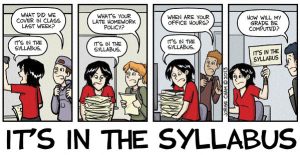Diversity and Inclusion – “It’s in the Syllabus!”

Many colleges and universities, including MSU Denver, have developed diversity, equity, and inclusion initiatives, which often offer plans around programs and events, hiring practices, and professional development. And while these initiatives are important steps in the right direction, it can be difficult for all faculty to see their role in these initiatives, particularly those whose research and teaching does not directly address issues of identity, power, and privilege. While the majority of MSU Denver faculty share a commitment to student retention and the success of diverse learners, not all are well versed in inclusive teaching strategies, and struggle with inclusive practices given the constraints of the course curriculum. Fortunately, syllabi are a feasible and effective vehicle for faculty to demonstrate the value of every student in their course.
Take a SIP of Diversity and Inclusion – “It’s in the Syllabus!”
Diversity and inclusion syllabus statements can offer powerful messages to students in all classes, regardless of discipline or course content. A diversity statement is a paragraph or section in a syllabus that welcomes including full spectrum of perspectives, especially those rooted in race, class, gender, religion, accessibility, and socioeconomic status. Faculty can use the diversity statement to set expectations for classroom discussions, encouragement for varying opinions, and standards of behavior both in class and during controversial campus events. A syllabus diversity statement signals belief that all students have value and bring unique perspectives worthy of consideration.
Research has shown that diverse student populations connect course material to daily life in different ways (Packard, 2013). By demonstrating respect for differences in intellectual exchange, diversity statements can show support towards different student practices and reduce students’ feelings of marginalization. These statements signal faculty awareness of potentially volatile campus conversations and encourage free exchange of earnest dialogue across a range of issues.
Thus below, we offer a sample statement that faculty can adapt for their own teaching, and we describe the process of creating the document – a partnership with faculty and students. This small step is something that all faculty can incorporate into their courses, regardless of content.
DIVERSITY AND INCLUSION STATEMENT: In an ideal world, the science and knowledge of (your course topic here) would be objective. However, much of science and knowledge is subjective and representative of a small subset of privileged voices. In this class, we will strive to draw on sources from a diverse group of scholars, but limits still exist on this diversity. I acknowledge that it is possible that there may be both overt and covert biases in the material due to the lens with which it was written. Integrating a diverse set of experiences is important for a more comprehensive understanding of (your course topic here). I would like to discuss issues of diversity in (your course topic here) as part of the course from time to time.
Please contact me (in person or electronically) or submit anonymous feedback* if you have any suggestions to improve the quality of the course materials.
Furthermore, I would like to create a learning environment for my students that supports a diversity of thoughts, perspectives and experiences, and honors your identities (including race, gender, class, sexuality, religion, ability, etc.) To help accomplish this:
- If you have a name and/or set of pronouns that differ from those that appear in your official MSU Denver records, please let me know!
- If you feel like your performance in the class is being impacted by your experiences outside of class, please don’t hesitate to come and talk with me. I want to be a resource for you. Remember that you can also submit anonymous feedback. If you prefer to speak with someone outside of the course, MSU Denver’s Campus Support Programs webpage is an excellent resource.
- I am still in the process of learning about diverse perspectives and identities. If I, or a classmate, says something in class that makes you feel uncomfortable, please talk to me about it.
As a participant in course discussions, you should also strive to honor the diversity of your classmates.
~ adapted from Monica Linden, Neuroscience, Brown University
“It’s in the syllabus!” is a popular answer to students’ questions. Here, we present a feasible way for all faculty to use their syllabi strategically. Of course, attention to diversity and inclusion across all aspects of a course is critical, but a syllabus statement is a relatively simple and important first step toward building inclusive classrooms.
Still Thirsty? Take Another SIP of Diversity and Inclusion – “It’s in the Syllabus!”
Additional resources and ideas for incorporating diversity and inclusion statements in your syllabus.
- Anonymous feedback from students by collected in class in writing, or electronically using online forms such as Qualtrics or Google Forms.
- MSU Denver Office of Diversity and Inclusion
- MSU Denver Center for Multicultural Excellence and Inclusion
- Yale Center for Teaching and Learning
- The Harriet W. Sheridan Center for Teaching and Learning
- Eberly Center Teaching Excellence & Educational Innovation
- Ambrose, Bridges, Lovett, DiPietro, and Norman (2010). How Learning Works: 7 Research – Based Principles for Smart Teaching. San Francisco: Jossey-Bass.
- Bart (2012). Strategies for Creating a More Inclusive Classroom. Faculty Focus.
- Harnish et al. (2011). Creating the Foundation for a Warm Classroom Climate: Best Practices in Syllabus Tone. Association for Psychological Science.
- Ludy, Brackenbury, Folkins, Peet, and Langendorfer (2016). “Student Impressions of Syllabus Design: Engaging Versus Contractual Syllabus.” International Journal for the Scholarship of Teaching and Learning 10.2 (1-23).
- Packard (2013). The Impact of Racial Diversity in the Classroom: Activating the Sociological Imagination. Teaching Sociology 41.2: 144-158.
